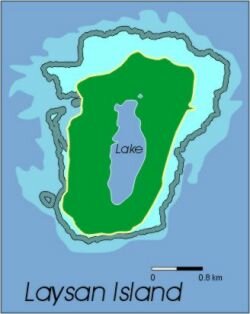Laysan is about 1.6 kilometers across and 2.4 kilometers long. Its poi board shape was formed by geologic uplift and by coral growth. It has fringing reefs and a hypersaline (very salty) lake in its interior, the only lake in the NWHI. A white sand beach surrounds Laysan's beautiful lake and is topped by dry coastal grasses. Sedges grow thick near the lake's edge.

The island's easy access and large number of seabirds made it a base for guano miners and feather harvesters in the late 1800s and early 1900s. The effects of guano mining, feather poaching, and the introduction of rabbits in the early 1900s, caused the Laysan albatross population to plummet from about 1 million in 1891 to about 30,000 in 1923.
Due to the dramatic loss of vegetation caused by rabbits, several species of land birds became extinct, including the Laysan honeycreeper and the millerbird. Two endemic species of land birds survivedthe hardy Laysan finch and the Laysan duck along with one endemic plant species.
Although introductions of alien species has changed the original fabric of the island's ecology, Laysan has benefited from years of concerted effort to mälama (take care of) the island. The U.S. Fish and Wildlife Service has eliminated pests, including rats, rabbits, and weeds, and has restored native vegetation. Laysan exemplifies restorative island efforts and is considered one of the crown jewels of the NWHI.
Populations of the endangered Laysan finch and Laysan duck are similar in size to those recorded in the early 20th century. More bird species now live on, or visit, Laysan than any other island in the Northwestern Hawaiian Islands. Huge populations of nesting seabirds and migratory shorebirds visit the island, including black-footed and Laysan albatross, Christmas and wedge-tailed shearwaters, and bristle-thighed curlews.
Although the reef at Laysan is the smallest of the NWHI (145,334 acres), it is quite rich. Numerous green sea turtles and Hawaiian monk seals appear on the island. Several species of Hawaiian surgeonfish and large schools of convict tangs are in the shallow, wave-washed waters around the island. Twenty-seven species of stony coral are reported, and branching corals are common.
|

